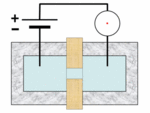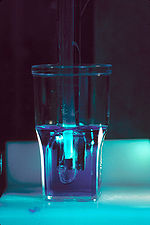- Coulter counter
-
A Coulter counter [1] [2] is an apparatus for counting and sizing particles suspended in electrolytes. It is used for cells, bacteria, prokaryotic cells and virus particles[3].
A typical Coulter counter has one or more microchannels that separate two chambers containing electrolyte solutions. As fluid containing particles or cells is drawn through each microchannel, each particle causes a brief change to the electrical resistance of the liquid. The counter detects these changes in electrical resistance.
Cells, being non-conducting particles, alter the effective cross-section of the conductive microchannel. If these particles are non-conducting, the electrical resistance across the channel increases, causing the electric current passing across the channel to briefly decrease. By monitoring such pulses in electric current, the number of particles for a given volume of fluid can be counted. The size of the electric current change is related to the size of the particle, enabling a particle size distribution to be measured, which can be correlated to mobility, surface charge, and concentration of the particles.
An American inventor named Wallace H. Coulter was responsible for the theory and design of the Coulter Counter. He first devised the theory behind its operation in 1947 while experimenting with electronics. Coulter determined that electrical charge could be used to determine the size and number of microscopic particles in a solution. This phenomenon is now known as the Coulter Principle.
The Coulter Counter is a vital constituent of today's hospital laboratory. Its primary function being the quick and accurate analysis of complete blood counts (often referred to as CBC). The CBC is used to determine the number or proportion of white and red blood cells in the body. Previously, this procedure involved preparing a blood cell stain and manually counting each type of cell under a microscope, a process that typically took a half hour.
Coulter Counters have a wide variety of applications including paint, ceramics, glass, molten metals and food manufacture. They are also routinely employed for quality control.
Other cell counting technologies that employ similar systems are also used, one of these being the CASY cell counting technology. These systems have some differences but operate on similar principles.
Due to the simple construction of these devices and the reliable sensing method, Coulter devices have found application in a broad range of particle analyses from blood cells to polymeric beads, DNA, virus particles and even metal ions. Quantitative measurements of the size and concentration of micro and nano scale particles has been accomplished using Coulter counters with reduced microchannel size so that particles pass one by one from one chamber to the other. Because this would substantially extend measurement times, multiple microchannels are used to reduce measurement times by counting particles in parallel with one another.
Another use of the Coulter principle is found in Scanning Ion Occlusion Spectroscopy (SIOS). Here a deformable membrane with a single nano-size aperture is used in order to characterize individual nano-scale particles during their transition across driven by either pressure or an electric field.
References
- ^ W.R. Hogg, W. Coulter; Apparatus and method for measuring a dividing particle size of a particulate system; United States Patent 3557352
- ^ U.S. Patent 7,397,232 Coulter counter
- ^ R.W. DeBlois, C.P. Bean (1970). "Counting and sizing of submicron particles by the resistive pulse technique". Review of Scientific Instruments 41 (7): 909–916. Bibcode 1970RScI...41..909D. doi:10.1063/1.1684724.
External links
- http://web.mit.edu/invent/iow/coulter.html
- US 2656508 Means for counting particles suspended in a fluid, October 20, 1953, Wallace H. Coulter
- "Dynamically resizable nanometre-scale apertures for molecular sensing"; Stephen J. Sowerby, Murray F. Broom, George B. Petersen; Sensors and Actuators B: Chemical Volume 123, Issue 1 (2007), pages 325-330
Categories:- Laboratory equipment
- Counting instruments
- Cell biology stubs
Wikimedia Foundation. 2010.


